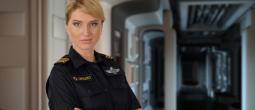

Lt. Commander Rob Hewson is an engineering officer, part of a team of officers and crew covering a range of engineering specialisations.
Given his particular training and experience he is responsible for managing the vessel’s power requirements and for monitoring the status of ship systems. This makes him a key engineering point of contact for the bridge.
What Would I be Doing?
Interested in Rob’s role as an engineering officer?
Once you've completed training at the Academy you'll be able to gain more experience by joining simulator missions chosen from a growing library of tactical, exploratory, scientific and diplomatic scenarios.
Depending on mission requirements you will co-ordinate with the bridge (or during alert conditions be on the bridge himself) to ensure necessary power allocation to implement mission requirements.
You’ll be drafting power allocation procedures for mission requirements and in combat situations you’ll need to manage that on the fly including sourcing emergency power or routing power around damaged areas of the vessel.
You’ll also monitor the status of vessel systems, providing diagnostic data if issues are detected and managing auxiliary power where necessary.
Rob is one of a number of engineering officers on the vessel, each managing different systems for which they have received specific training.
 Generation
Generation
This is Rob’s specialislation, involving the management of power generation and distribution systems, including the allocation of power between vessel systems. This specialsation also includes management of the vessel's reactors and auxiliary power systems.
 Propulsion
Propulsion
The vessel's main propulsion is provided by Magnetoplasma Impulse Engines (MIEs) which allow significant sublight speeds to be reached for maneuvering within star systems. The MIEs are used in conjunction with an alien-derived faster-than-light (FTL) drive system which provides speeds multiple times the speed of light for travel between star systems.
 Spaceframe
Spaceframe
The vessel's superstructure is referred to as the spaceframe - effectively an armoured shell within which the crew and all other vessel systems operate.
Maintaining the structural integrity of the spaceframe during high-impact mission or combat operations is vital to the survival of the vessel.
Becoming an Engineering Officer
Engineering officers are specialists and so are more focused on their area of expertise than regular line officers, although they will still be expected to manage teams.
As specialists, engineering officers can follow either an officer or warrant officer career track, usually depending on where they studied – at a military academy or a university.
First Steps
It starts by signing up as a cadet or candidate (depending on the career track chosen).
You’ll be asked to choose a relevant ship system to train on. When you successfully complete the training course you’ll be qualified (or ‘rated’) to operate that system on missions. You’ll also be promoted.
Tip
In crisis situations everyone looks to engineers for options. This requires not just the system operation skills you’ll get from training but also a thorough knowledge of your chosen system’s operating principles and underlying theory.
Gaining Experience
Endeavour’s mission offers a unique opportunity for engineers to gain experience by solving problems and improving their systems from the unique challenges and problems that emerge from each encounter.
As you participate in missions your experience will be logged and will be recognised as a step up in rank.
Training on additional ship systems will also help your advancement and widen the range of missions you can participate in.
Advanced system training will help you advance to the highest ranks.
Not Sure?
Choosing your first rating doesn’t lock you into any particular career track or role. Choose something that interests you so that you can try simulator missions and get a feel for what you enjoy most.
There are no barriers to changing career tracks at any time. Your accumulated experience and ratings are fully transferable.









